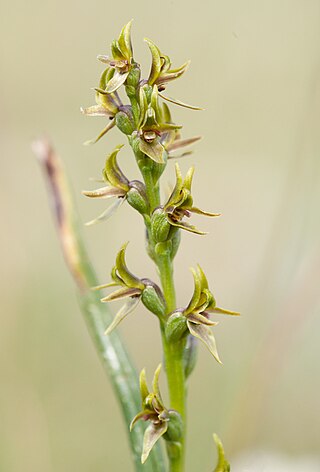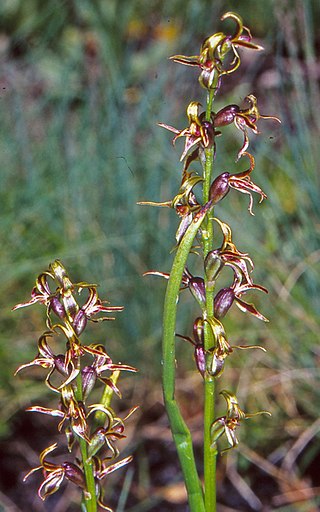
Prasophyllum tadgellianum, commonly known as the alpine leek orchid, is a species of orchid native to the Snowy Mountains and Tasmania. It has a single stiff, erect leaf and up to twenty scented, greenish-brown or reddish-brown flowers crowded on a stout spike.
Prasophyllum pyriforme, commonly known as the graceful leek orchid is a species of orchid species endemic to eastern Australia. It has a single tubular leaf and up to fifty greenish flowers with a pink or white labellum. As with others in the genus, the labellum is above the column rather than below it.
Prasophyllum australe, commonly known as the southern leek orchid or austral leek orchid, is a species of orchid and is endemic to south-eastern Australia. It has a single tubular, green leaf and up to fifty scented, greenish-brown flowers with red stripes.

Prasophyllum sphacelatum, commonly known as the subalpine leek orchid, is a species of orchid endemic to south-eastern Australia. It has a single tubular, dull green leaf and up to eighteen scented, green to brownish flowers with a green to pinkish labellum. It grows in subalpine areas of New South Wales, Victoria and Tasmania.

Prasophyllum odoratum, commonly known as the fragrant leek orchid, Rogers scented leek orchid or sweet leek orchid is a species of orchid endemic to south-eastern Australia. It has a single tubular leaf and up to fifty fragrant green and white flowers with reddish marks.
Prasophyllum barnettii, commonly known as the Anglesea leek orchid, is a species of orchid endemic to Victoria. It has a single tubular leaf and between twelve and thirty scented yellowish, reddish or brownish flowers and is only known from a small area in the south of the state.
Prasophyllum brevilabre, commonly known as the Gorae leek orchid, is a species of orchid endemic to south-western Victoria. It has a single tubular, green leaf and up to forty greenish-brown flowers with reddish markings. It is a very rare orchid, now only known from two small, scattered populations. It was first recorded from Gorae West near Portland but is no longer found there.
Prasophyllum fosteri, commonly known as the Shelford leek orchid, is a species of orchid endemic to a small region of Victoria. It has a single tubular green leaf and up to twenty five green to reddish-brown flowers. It is a very rare orchid, only known from a single population on a roadside.

Prasophyllum fuscum, commonly known as the slaty leek orchid or tawny leek orchid, is a species of orchid endemic to a small region of New South Wales. It has a single tubular green leaf and up to thirty greenish brown to reddish brown flowers. There is debate about the taxonomy of the species with some authorities considering Prasophyllum uroglossum as a separate species. Only about twenty five plants are known to survive in south-western Sydney.
Prasophyllum gilgai, commonly known as the gilgai leek orchid, is a species of orchid endemic to Victoria. It has a single tubular green leaf and up to twenty greenish brown, light brown, pink or white flowers. It is a very rare orchid with a population of fewer than fifty plants in a small area in the north of the state.
Prasophyllum incorrectum, commonly known as the golfer's leek orchid, is a species of orchid endemic to Tasmania. It has a single tubular, dark green leaf and up to twenty scented, yellowish-green and reddish-brown flowers. The largest population occurs on a golf course.
Prasophyllum litorale, commonly known as the coastal leek orchid, is a species of orchid endemic to southern continental Australia. It has a single tubular leaf and up to forty flowers with red and green colouring and grows in sandhills near the sea.

Prasophyllum maccannii, commonly known as the inland leek orchid, is a species of orchid endemic to Victoria. It has a single tubular green leaf and up to forty green, greenish-pink or brownish flowers. It is found in the central-west of the state, growing in open forest.

Prasophyllum morganii, commonly known as the Cobungra leek orchid, is a species of orchid endemic to a small area in Victoria. It has a single tubular leaf and up to eighty greenish flowers with purplish markings. Before being rediscovered in 2020, the plant had last been seen in 1933 and was presumed extinct.
Prasophyllum niphopedium, commonly known as the marsh leek orchid, is a species of orchid endemic to a small area in Victoria. It has a single tubular leaf and up to twenty greenish flowers with reddish markings. It is only known from five population on grassy alpine plains with the total number of individual plants less than five hundred.
Prasophyllum pallidum, commonly known as the pale leek orchid, is a species of orchid endemic to a south-eastern South Australia. It has a single tubular leaf and up to thirty green or yellowish-green flowers. It was previously thought to occur in Victoria but records from that state are now recognised as P. roseum.
Prasophyllum readii, commonly known as the Streathem leek orchid, is a species of orchid endemic to Victoria. It has a single, tubular leaf and up to twenty five scented, greenish-brown to reddish-brown flowers with a white or pinkish labellum and is only known from a swamp in the south-west of the state.
Prasophyllum retroflexum, commonly known as the congested leek orchid or Kiandra leek orchid, is a species of orchid endemic to a small area near the border between New South Wales and Victoria, growing in subalpine herbfields. It has a single tubular leaf and up to forty densely-crowded, pale green flowers with pinkish markings.
Prasophyllum suaveolens, commonly known as the fragrant leek orchid, is a species of orchid species endemic to inland Victoria. It has a single bright green, tube-shaped leaf with a reddish base and up to twenty five green to yellowish-green flowers with red markings. The flowers are the smallest of any leek orchid found in Victoria.
Prasophyllum uvidulum, commonly known as the summer leek orchid, is a species of orchid endemic to Victoria. It has a single, tubular leaf and up to twenty five scented, pale green flowers with reddish markings and is only known from a swamp in the north-east of the state.







